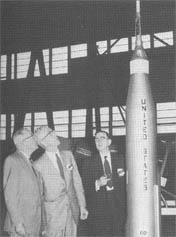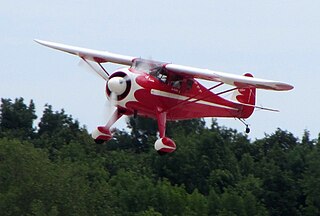
The Howard DGA-15 was a single-engine civil aircraft produced in the United States by the Howard Aircraft Corporation from 1939 to 1944. After the United States' entry into World War II, it was built in large numbers for the United States Navy and also served various roles in the United States Army Air Forces.

The Monocoupe 90 was a two-seat, light cabin airplane built by Donald A. Luscombe for Monocoupe Aircraft. The first Monocoupe was built in an abandoned church in Davenport, Iowa, and first flew on April 1, 1927. Various models were in production until the late 1940s.

The Howard DGA-8, DGA-9, DGA-11, and DGA-12 were a family of four-place, single-engine, high-wing light monoplanes built by the Howard Aircraft Corporation, Chicago, Illinois from 1936.

The Howard DGA-6 was a pioneer racing plane, nicknamed "Mister Mulligan". It was the only airplane ever designed for the specific purpose of winning the Bendix Trophy. The plane was designed and developed by Ben Howard and Gordon Israel, who later became an engineer for the Grumman Aircraft Engineering Corporation. Mister Mulligan was designed to fly the entire length of the race nonstop and at high altitude. Neither had ever been done before. Mister Mulligan won the trophy, and thus changed the way in which long distance airplanes were designed.

Howard Aircraft Corporation was a small United States aircraft manufacturer in the 1930s and 1940s. The factory was initially on the south side of Chicago Municipal Airport at 5301 W. 65th Street; during World War II a second plant was opened at DuPage Airport west of Chicago.

Ira H. Abbott was an American aerospace engineer. After graduating from MIT, Abbott started working for Langley Aeronautical Laboratory in 1929. He contributed significantly to the establishment of high-speed research programs and published numerous technical reports on aerodynamics. He eventually attained the post of assistant chief of research at Langley in 1945.
The Gatard Statoplan AG 02 Poussin was a light, single-seat sports airplane developed in France in the late 1950s and marketed for homebuilding. In layout, it was a low-wing cantilever monoplane of short-coupled design with fixed tailwheel undercarriage. Construction was a plywood-covered wooden structure throughout, and the cockpit was enclosed by a large perspex bubble canopy. The variable-incidence horizontal stabiliser was fitted with small endplates to provide extra directional stability but there were no separate elevators.
The Prue 215 is an American high-wing, V-tailed, single-seat glider that was designed by Irving Prue in 1949.

The Howard DGA-3 "Pete", a.k.a. "Damned Good Airplane – 3", "Baker Special", and "Little Audrey" was the third aircraft built by Ben Howard, and the first in a series of racing aircraft. Howard claimed that the aircraft was so fast from his use of "Go Grease".

The Kimball McCullocoupe is a homebuilt aircraft built around the design of the Clipwing 110 Special Monocoupe.
The Smith X-99 Prop-Jet was a six-seat turboprop powered business aircraft designed in the United States in the 1980s. Only one was built.

The Legrand-Simon LS.60 is a single-engine, high-wing monoplane seating two side-by-side. It was built in France in the early 1960s in response to a government competition for a club trainer. It won the competition but nevertheless failed to go into production; only the prototype, which still flies, was completed.
The CVV1 Pinguino was a single seat, high performance glider designed and built in Italy in the mid-1930s, the first of a series of gliders from the Milan Polytechnic. It did not go into production.

The Coupé-Aviation JC-01 is the first of a series of very similar designs of two seat, single engine sports aircraft, amateur built from plans in France from 1976. These provided a range of engine sizes and undercarriage layouts, but total production was small.
The Aviator Shershen' is a Russian two seat biplane, sold in kit form. It first flew in 2005 and several variants have been produced, with a choice of engines.

The Speedtwin E2E Comet 1, originally named the Phillips ST1 Speedtwin, is a two-seat, twin engined aircraft designed in the UK to be capable of aerobatics and the only civil twin certified for intentional spinning. After a long development time, just two have been built.
The IIL IS-5 was a single seat, high performance sailplane designed by Iosif Șilimon and built in Romania in 1960.
The Landray GL.01 is a small tandem-wing, side-by-side seat sport aircraft of the Mignet Pou-du-Ciel type. Built in the mid 1970s, the single example remains active.
The Lambert Twin Monocoach was a light, twin-engined U.S. aircraft, designed to carry three or four passengers. Initially it was fitted with economical, low-powered engines but even given a large increase of power it failed to attract customers.
The IPAI-26 Tuca was a Brazilian single engined high-wing light utility aircraft.











